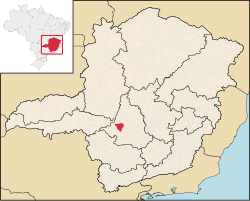Luz, Minas Gerais
| Luz | |
|---|---|
| Municipality | |
 Location in Minas Gerais state |
|
| Location in Brazil | |
| Coordinates: 19°48′3″S 45°41′9″W / 19.80083°S 45.68583°WCoordinates: 19°48′3″S 45°41′9″W / 19.80083°S 45.68583°W | |
| Country |
|
| Region | Southeast Region |
| State | Minas Gerais |
| Mesoregion | Central Mineira |
| Microregion | Bom Despacho |
| Area | |
| • Total | 1,172 km2 (453 sq mi) |
| Population (2015) | |
| • Total | 18,290 |
| • Density | 16/km2 (40/sq mi) |
| Time zone | BRT/BRST (UTC-3/-2) |
Luz is a Brazilian municipality located in the West (south of the west) part of the state of Minas Gerais. Luz is located between the city of Araxá and the capital city of the state of Minas Gerais, Belo Horizonte. The population is 18,290 (2015 est.) in an area of 1172 km². The city belongs to the Central Mineira region and to the micro-region of Bom Despacho. It became a municipality in 1923.
In the region there was a spring with a dam that supplied water to the small settlement that had grown around a chapel dedicated to Our Lady of the Light, or Nossa Senhora da Luz. The first name of the town was Nossa Senhora da Luz do Aterrado, or Our Lady of the Light of the Dam.
The city center of Luz is located at an elevation of 675 meters a short distance south of federal highway BR-262. The São Francisco River lies to the east. Neighboring municipalities are: Estrela do Indaiá and Dores do Indaiá (N), Bom Despacho (NE), Moema and Lagoa da Prata (E), Japaraíba (SE), Arcos and Iguatama (S), Bambuí and Córrego Danta (W). *
Distances
Elevation
Temperature
Rainfall
Topography
Rivers
Services, small industries, and agriculture are the most important economic activities. Charcoal production from eucalyptus plantations is also important. In 2005 there were 78 transformation industries employing 540 workers and 342 retail units employing 926 workers. The GDP in 2005 was approximately R$158 million, with 11 million from taxes, 77 million reais from services, 17 million reais from industry, and 52 million reais from agriculture. There were 651 rural producers on 69,000 hectares of land. 183 farms had tractors (2006). Approximately 1700 persons were occupied in agriculture. The main crops are coffee, rice, beans, and corn. There were 96,000 head of cattle, of which 24,000 were milk cows (2006).
...
Wikipedia

